Theatre Review: Sing It To My Face – Auckland Town Hall, October 17, 2019
Sing It To My Face is an intergenerational production performed by 100 individuals split into four groups, each with their own distinct voice and perspective on life – expressing what they think of each other and how their own unique dreams and difficulties shape the world they live in.
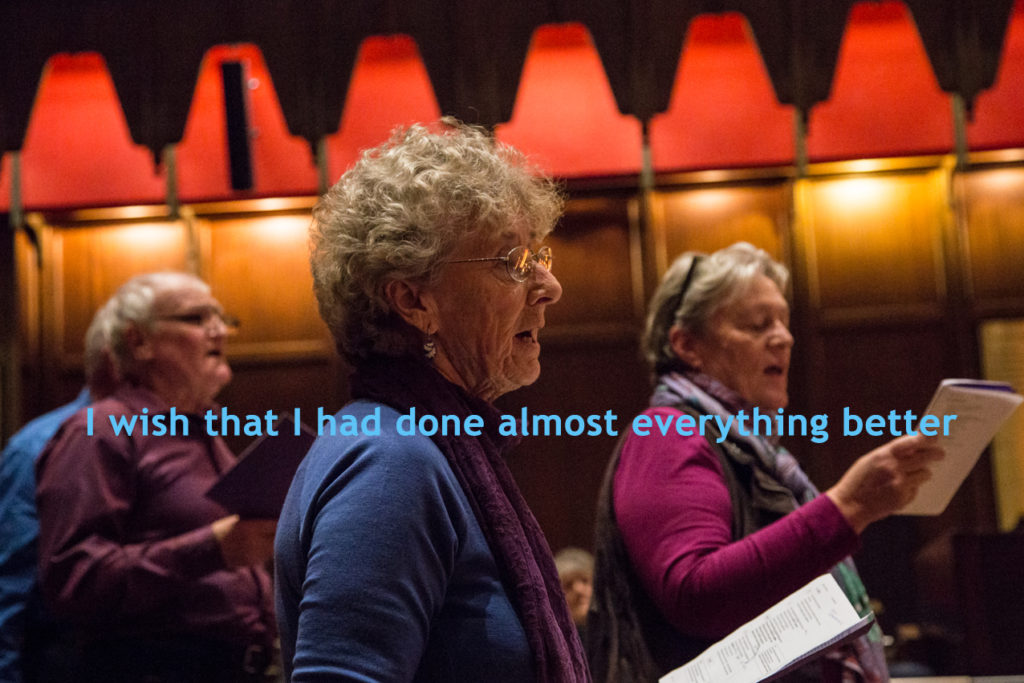 Gosh I love theatre. There’s something so unavoidably confrontational and intimate about it; you can hear the rise and fall in an actor’s voice and breath, catch their eye and find a line delivered directly into your soul, and it’s raw human expression in its purest, most refined form. You’re present for all the highs and lows, the flaws and imperfections – but crucially, you’re present.
Gosh I love theatre. There’s something so unavoidably confrontational and intimate about it; you can hear the rise and fall in an actor’s voice and breath, catch their eye and find a line delivered directly into your soul, and it’s raw human expression in its purest, most refined form. You’re present for all the highs and lows, the flaws and imperfections – but crucially, you’re present.
Unfortunately, I don’t get to see as much theatre as I’d like to, so when I was asked to review Sing It To My Face last night, I jumped at the chance after barely finishing the first sentence of the show’s synopsis. Before I dive in to my review and how I felt about Sing It To My Face, I’ll quickly address the question you may be asking: should you see this production? Yes. Absolutely, yes.
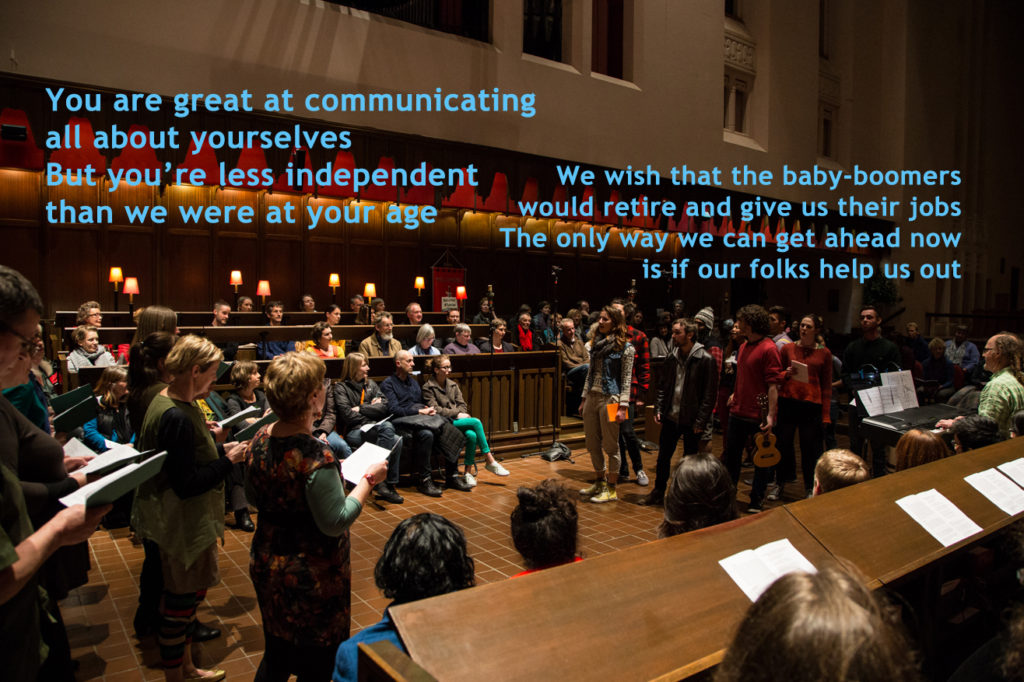 Performed in the Concert Chamber of Auckland Town Hall, Sing It To My Face is an hour-long production brought to life by Barbarian Productions and its 100-strong cast. The show is fairly simple in its concept yet complex in its depth: the cast is split into three generational groups – Under 30s, 30-60s, and Over 60s – and perform songs compiled from public responses throughout the Wairarapa, Wānaka, Pōneke, and Tāmaki Makaurau regions of Aotearoa.
Performed in the Concert Chamber of Auckland Town Hall, Sing It To My Face is an hour-long production brought to life by Barbarian Productions and its 100-strong cast. The show is fairly simple in its concept yet complex in its depth: the cast is split into three generational groups – Under 30s, 30-60s, and Over 60s – and perform songs compiled from public responses throughout the Wairarapa, Wānaka, Pōneke, and Tāmaki Makaurau regions of Aotearoa.
The complexity of the production is in its multilayered performance, which sees each group expressing how they feel about themselves, their place in the world, and the other generational groups. Its simplicity is apparent in the relatively bare performance space; the performers stand in groups in the centre of the Concert Chamber and sing to each other and the audience, supported by a small number of musicians, and with the production’s libretto presented on multiple screens throughout the performance space.
 It’s a remarkably intimate production, both through the proximity of the performers to the audience and the vocalising of anonymous, but real responses from New Zealanders across our country. Before the performance began, the audience was given a brief introduction by Text Arranger and Creative Director, Jo Randerson, and guided through some audience-participation moments by Composer and Musical Director, Julian Raphael.
It’s a remarkably intimate production, both through the proximity of the performers to the audience and the vocalising of anonymous, but real responses from New Zealanders across our country. Before the performance began, the audience was given a brief introduction by Text Arranger and Creative Director, Jo Randerson, and guided through some audience-participation moments by Composer and Musical Director, Julian Raphael.
It was a sweet and inclusive way to begin the show, with the first group – the 30-60s – facing the audience with welcoming and genuine smiles and encouraging them to free themselves of any audience-participation anxiety. More than a few of the audience immediately joined in and, later, this initial act of inclusion saw much of the audience singing along in their own way: joyously, softly, or silently, but uniformly toward the performers themselves.
 The text of the performance is as diverse as the performers, touching on technology, education, relationships, narcissism, social media, modern history, greed, climate change, war, peace, drugs, compassion, cruelty, and almost the entire spectrum of human existence. We see the 30-60s group champion their efforts toward creating peace, justice, kindness, and great music. They examine the result of their efforts – world-changing inventions that brought unmanageable pollution, a world stripped bare of resources, a cynical and disconnected society happily numbed through trash entertainment.
The text of the performance is as diverse as the performers, touching on technology, education, relationships, narcissism, social media, modern history, greed, climate change, war, peace, drugs, compassion, cruelty, and almost the entire spectrum of human existence. We see the 30-60s group champion their efforts toward creating peace, justice, kindness, and great music. They examine the result of their efforts – world-changing inventions that brought unmanageable pollution, a world stripped bare of resources, a cynical and disconnected society happily numbed through trash entertainment.
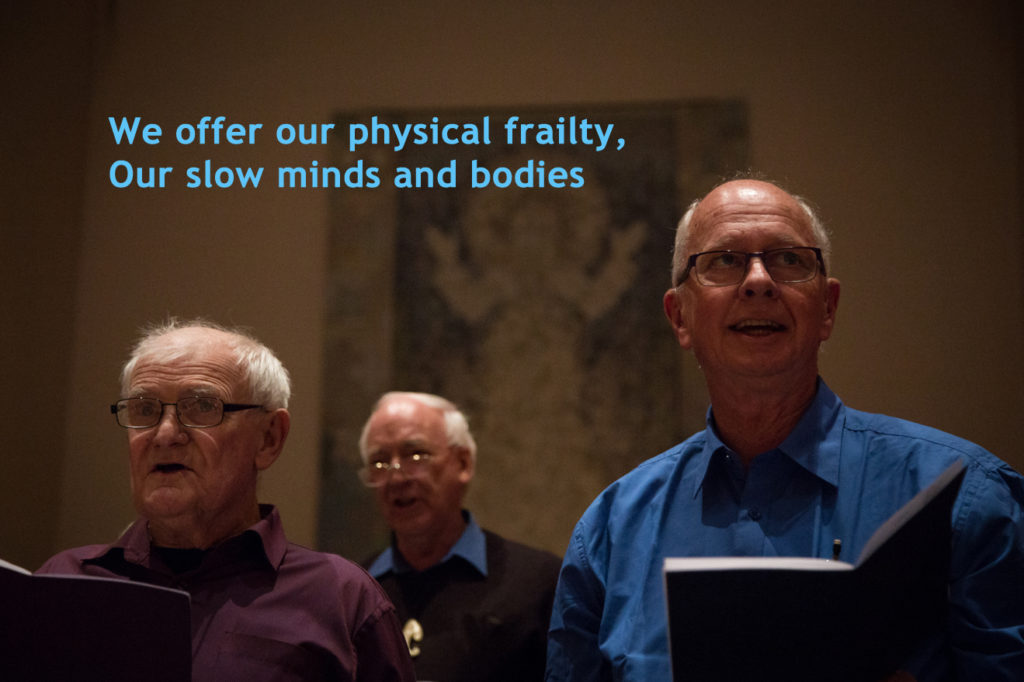 We see the Over 60s expressing concern for this younger group; overworked, preoccupied, always taking on too much, doing too much, shouldering the responsibility for all the world’s failings and shortcomings, struggling, struggling, struggling to make a life worthy of living. They impart wisdom; to see everyone not as a challenge but as a source of support, to recognise themselves as the role models they are for an even-younger generation, to enjoy the moment, be free of regrets, and to dance – always, to dance and feel free.
We see the Over 60s expressing concern for this younger group; overworked, preoccupied, always taking on too much, doing too much, shouldering the responsibility for all the world’s failings and shortcomings, struggling, struggling, struggling to make a life worthy of living. They impart wisdom; to see everyone not as a challenge but as a source of support, to recognise themselves as the role models they are for an even-younger generation, to enjoy the moment, be free of regrets, and to dance – always, to dance and feel free.
The two groups find commonalities in these moments, bridging the gap between years and closing the distance between separated perspectives on the world – the 30-60s thanking their elders for demonstrating how to appreciate life, their acknowledgement of human sacrifice made in wars throughout the last century and their patience, their protests for peace, their invention of the Internet, and championing women’s rights.
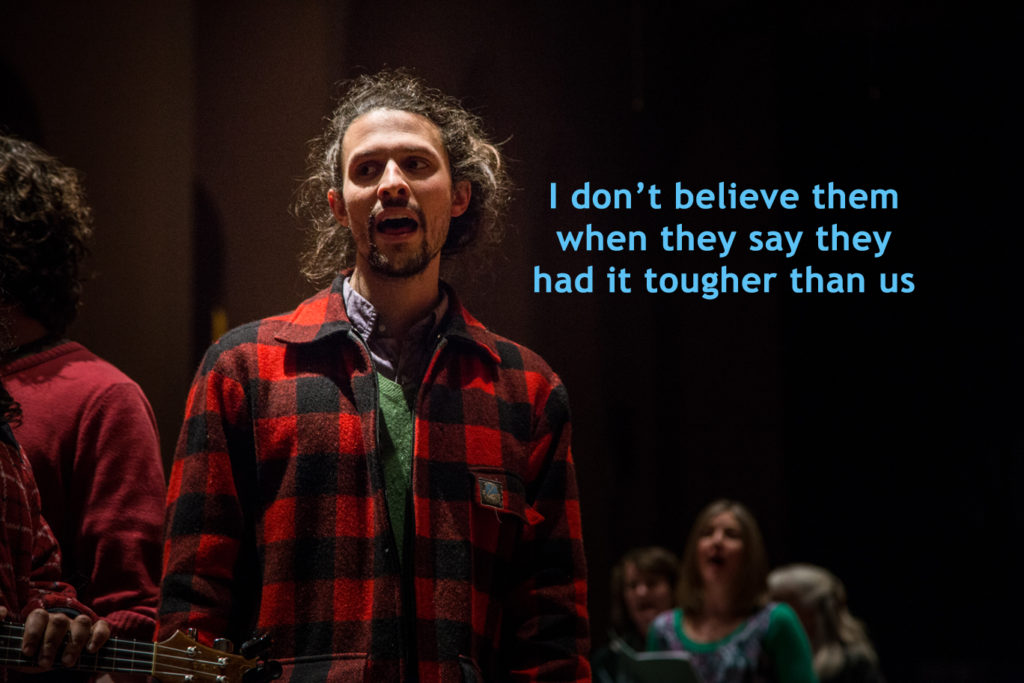 This moment is interrupted by the first of the Under 30s – late teens to young adults – who playfully tell both groups their generation ‘is pretty lit really’ and wish ‘the baby boomers would retire, and give us their jobs’. They share their desire to live, despite the difficulties presented by mindless, soul-destroying minimum-wage jobs and an acceptance that, before 30, they realise they may work until the day they die. They denounce racism, sexism, homophobia – they reveal their crippling anxieties, their desire for diversity and a loving world.
This moment is interrupted by the first of the Under 30s – late teens to young adults – who playfully tell both groups their generation ‘is pretty lit really’ and wish ‘the baby boomers would retire, and give us their jobs’. They share their desire to live, despite the difficulties presented by mindless, soul-destroying minimum-wage jobs and an acceptance that, before 30, they realise they may work until the day they die. They denounce racism, sexism, homophobia – they reveal their crippling anxieties, their desire for diversity and a loving world.
With these three groups on stage, each trying to voice their concerns, objections, wisdom and advice, these messages soon overlap, growing increasingly distorted and manic. Suddenly, there’s nothing but noise before your eyes, groups of beautiful, expressive humans from all walks – and at all stages – of life yelling to be heard, all of it drowned out against the other. This moment hit me hardest, to witness equal messages of hope and pain lost in a sea of noise, disagreement, and discontent. That by wanting to change everything, by only seeing the flaws in our world and others, we forget to listen and connect with each other.
We make it our righteous mission to throw ourselves into correcting wrongs because we believe we are right, and this exhaustion makes us weary, cynical, and bitter. We become hesitant of others and their views, we fail to listen, and we fail to live and love.
“So many voices, so much confusion, where do I fit, struggling to find connection, looking for role models, searching internally, cluttered minds,” the Under 30s sang.
 The show closed with the second Under 30s group arriving to the centre of the room, a group of young children huddled in an outwardly facing circle, the lights dimmed to a soft, electric blue, and the other groups humbly lowering themselves down to the floor to listen. The exceptional music support by Julian Raphael on piano, J.Y. Lee on wind instruments, and Marika Balzat on violin gently lowered themselves in volume alongside.
The show closed with the second Under 30s group arriving to the centre of the room, a group of young children huddled in an outwardly facing circle, the lights dimmed to a soft, electric blue, and the other groups humbly lowering themselves down to the floor to listen. The exceptional music support by Julian Raphael on piano, J.Y. Lee on wind instruments, and Marika Balzat on violin gently lowered themselves in volume alongside.
I have no shame in admitting their arrival brought my hand to my chest, that it broke my heart to hear their beautiful naivety, but it also brought perspective to the performance as a whole: the message of this group wasn’t about their individuality, but their collectiveness – they want fewer poor people, enough food to eat, beautiful forests, and animals to meet. They want the sun to shine and the rain to fall, for us to remember and recognise the magic in all of us, and for the dinosaurs to come back. They didn’t dispense blame, instead they imparted the pure wisdom of a child’s untainted lens for life.
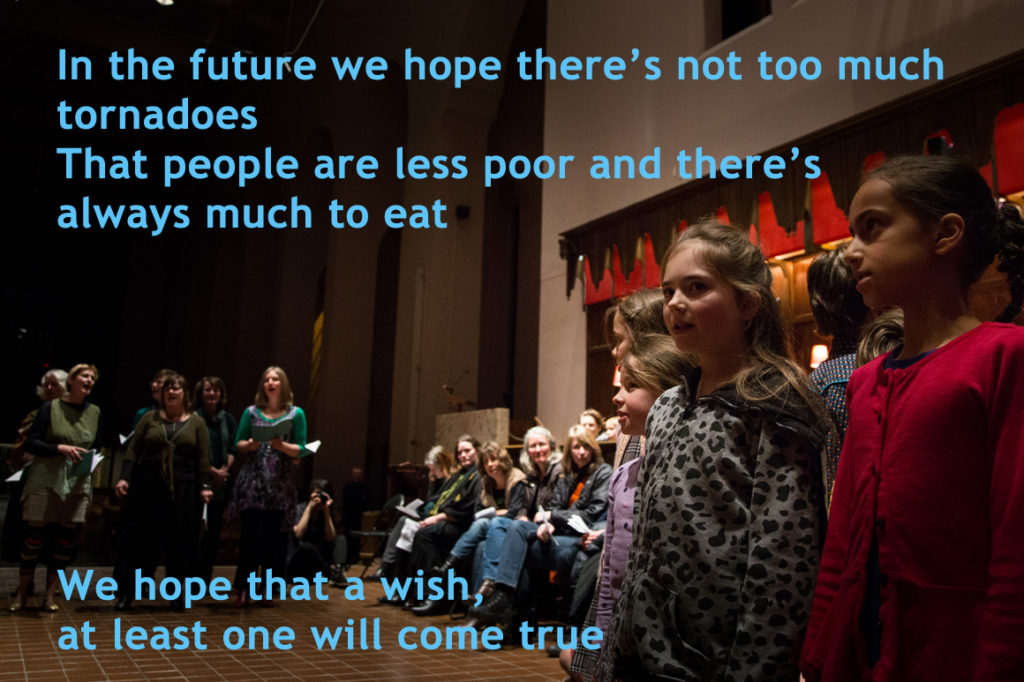 For me, this was a reminder that we are all one. One species, one community, one evolving generation of consciousness. We are human, all of us, each with our own voice and beauty, our own pain and capacity for love. In an effort to make our voices heard above the sea of noise and discontent in our world, we forget to listen and connect with others, and in doing so we ignore how exquisitely beautiful the world and the people of the world can be when we do.
For me, this was a reminder that we are all one. One species, one community, one evolving generation of consciousness. We are human, all of us, each with our own voice and beauty, our own pain and capacity for love. In an effort to make our voices heard above the sea of noise and discontent in our world, we forget to listen and connect with others, and in doing so we ignore how exquisitely beautiful the world and the people of the world can be when we do.
~ Oxford Lamoureaux
Sing It To My Face will run from 18 October – 20 October at Auckland Town Hall, with tickets available from Auckland Live: https://www.aucklandlive.co.nz/show/sing-it-to-my-face
- The Dead South – Powerstation: April 5, 2024 (Concert Review) - April 6, 2024
- Queens of The Stone Age – Spark Arena: February 29, 2024 (Concert Review) - March 1, 2024
- Dune: Part Two – Dir: Denis Villeneuve (Film Review) - February 29, 2024
